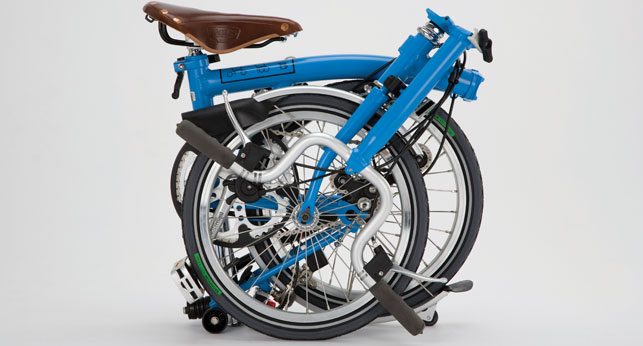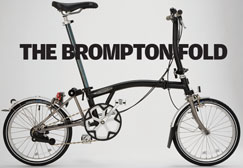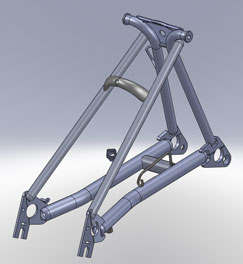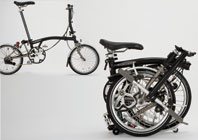It’s becoming a rarity to find a company that both designs and manufactures in the UK and rarer still for it to have a West London postcode.
But, from a 2,000m2 site located in walking distance of Chiswick high street, folding bike specialist, Brompton now produces over 26,000 bicycles a year.


A whole world of colour, the Brompton bicycles are an attractive choice for commuters
From brazers, assemblers, office workers, designers and engineers, over 100 staff from all over the London area come to the site everyday to play their part in building a bicycle from scratch, and most arrive on the machines they build. And with over three quarters of a bicycle’s 1,200 components being unique to Brompton, the company also has to design and build the machines, tools and fixtures needed to manufacture these unique parts, including over 500 purpose-made press tools, moulds, braze jigs and assembly fixtures.
The brainchild of Andrew Ritchie, Brompton has had a tumultuous past but 30 years on from the first prototypes, over 175,000 Bromptons have now been sold worldwide and the company remains true to its philosophy of providing people with a personal transport solution that allows them to rethink how they get around.
Although there are other folding bicycles on the market, there are none quite like the Brompton – a full-sized, robust yet agile steel frame that can be easily and quickly converted into a compact, portable package. In fact, with a little practice, the Brompton can be folded in 10 to 20 seconds. Then, weighing just 9kg to 12.5kgs (depending on the model and configuration), it can be easily picked up and carried onto a train or into work to be placed under a desk or in a cupboard until the journey home.

Click above to expand on how the Brompton bicycle contracts
Up until the year 2000 Ritchie was not only Brompton’s managing director but also its chief designer. The company’s second designer was employed shortly after Sturmey Archer, the Nottingham-based hub gear manufacturer, was forced into bankruptcy in September 2000. This had a profound effect on Brompton as it relied on Sturmey Archer’s three and five speed hub gears, which were fitted to every Brompton model. Fortunately, a new hub gear manufacturer was found – SRAM in Germany – but in order to buy time to reengineer the bicycles around it, Ritchie went over to Nottingham to secure as many Sturmey hubs as he could.
“I had been at Sturmey Archer for 13 and a half years in total when I was laid off,” says Steve Rickels, who at that time was Sturmey Archer’s design manager. “I met Andrew Ritchie in the car park when he came to pick up the last of the gear hubs and he asked whether I wanted a job.” Rickels of course said yes and ten years later he is still Brompton’s design manager and heads up a design department that now consists of four designers.
The digital dawn
When Rickels first started, his primary task was to convert all the drawings into CAD. “Initially all the drawings for the original bicycle were all done on tracing paper,” he says. “I redrew a lot of these in AutoCAD and Mechanical Desktop because that is what I knew and had used in the past.” However, a year and a half ago with more designers on board, which ultimately meant more software licenses, and the fact that Autodesk was no longer supporting Mechanical Desktop, Rickels had to find new CAD software.
“We had to abandon Mechanical Desktop because it was an obsolete programme,” he explains. “We had basically set ourselves a choice of either SolidWorks or Inventor. In the end, after a lot of debating, we decided that the best thing to do would be to go with SolidWorks because we felt that more of our suppliers were using it.”
SolidWorks is now used at Brompton for designing new components, redrawing the bicycle and converting all the old Mechanical Desktop files over to SolidWorks, and also designing specialist tooling and equipment for the factory.
Small steps
The principle of the folding bicycle Ritchie conceived over 30 years ago is more or less the same today however, the design has evolved year on year through a continuous process of small incremental steps. An example of such a step was the creation of the rear frame clip a few years back.
Previously, without this feature the rear wheel would just fall down whenever the unfolded bike was picked up. Although many Brompton users liked this as it enabled them to park their bicycle instantly, others found it disconcerting. They would prefer that the rear frame was attached in some way as it would make them feel more comfortable whilst riding it and also for it to remain in one piece when picked up.
As a rule, the company refuses to design obsolescence into its bikes, so this meant that any new improvement had to be capable of being retrofitted to older Bromptons. “Lots of people had been asking us for a rear frame clip and we knew that as soon as we did this there would be a lot of pent up demand for people to retrofit it to their old bike. So it was key that this feature had to be retrofittable,” says Rickels.

A Brompton rear frame modeled in SolidWorks; meanwhile founder Andrew Ritchie (left of click-through image) passes on his years of experience to his shop floor staff
Rickels worked on creating a rear frame clip that would give the choice of either latch mode or non-latch mode, depending on the user’s preference. The solution he came up with was to design a recess into the rear suspension block. When the block was turned so that the recess was on the bottom, the clip would automatically engage. For non-latch mode, the user simply turns the block through a quarter turn so that the recess is in a different place and so no longer engages.
“The beauty with this design is that the Brompton owner can have both the original design as well as the new design all in one part,” says Rickels, explaining that in order to create an elegant solution he used CAD (at this time they were still using Mechanical Desktop). “Obviously this was easier to do in CAD than it was to do on a drawing board,” he comments. “Once we had decided on a CAD model we were able to get an ABS plastic rapid prototype made by sending the CAD files to our plastic moulders. Although the prototype was not a perfect finish, it’s functional and we can get a much better feel for how it would look.”
The rear frame clip is now available on all new Bromptons and any owners who wish to fit it to their old models can purchase a retrofit kit. “This is a good example of a small incremental step to some extent. It’s an improvement to the design and it didn’t add any weight in the end, or just a couple of grams overall,” says Rickels.
Giant leaps
The evolutionary design process that Brompton employs is occasionally boosted by some fundamental improvements. Over the past few years one of these changes has been the reengineering of the hinge on the mainframe into a malleable casting. This also allowed the wheelbase to be extended by a few centimetres and as such, increase the stability of the ride. However, such a major change to the bicycle also meant retooling and redesigning the brazing jigs as they are not generic. “You just change one thing and it’s a domino effect all the way down – you have to sort everything out,” comments Rickels.
Brompton’s jigs are crucial because without them the brazers can’t perform the high quality craftsmanship that the company is renowned for. As opposed to the more common practice of welding, brazing is a highly-skilled and labour intensive process. Using a gas flame, a filler metal (in this case a brass compound) is heated to melting temperature and distributed between two or more close-fitting steel parts to join them without deformation. Due to the folding nature of the bicycles, many of its joins are highly technical and consequently, it can take up to two years for a brazer to be competent in all aspects of Brompton frame building.
In order to showcase its brazing craftsmanship, six years ago Brompton decided to go to a bike show to exhibit a model that was just a steel frame painted in a transparent lacquer so visitors could see the neat brazing on the joins. Although, it wasn’t its intention, Brompton started taking orders for this bicycle at the show and today it is one of their more popular models, despite the fact that people have to pay a premium for the attention that has to be paid to the frame during production.
Tooled up
Much of the tooling, including the brazing jigs, are unique to Brompton so they are all designed in-house. “We have changed the jigs over the years to improve them as we have learnt. Sometimes combining more than one brazing operation on one jig,” says Rickels. He and one of the other designers are currently working full time on tool design and have recently designed a brazing fixture in SolidWorks for a new auto braze machine.

In 2009, Ritchie was awarded, presented annually to recognise a lifetime contribution to design
“To some extent the jigs are where a great deal of the expertise is because anybody could go buy a Brompton bicycle, measure it and try and produce a copy. But without the tooling for the brazing and everything else they are going to find it difficult to make an accurate bike just by doing it by hand,” says Rickels. Additionally, it would be difficult to imitate because with all the different components in a folding bike, they have to work to very tight tolerances (most of the time 0.1mm) in order to ensure the highly accurate frame alignment.
As Brompton has currently more demand than it can build, the company is looking to reorganise the factory in order to optimise the space and increase production. At the moment all the brazers are located on one side of the factory building the frames. Once these frames return from being painted by an outside company, they are then put on trolleys with all the other components needed to build ten bikes and wheeled over to the bike builders on the other side of the factory.
Each bike builder can build between 15 to 20 bikes a day, which equals roughly 120 bikes in total. However, in order to reach their goal of producing 35,000 bikes this coming year the manufacturing team is planning to move from batch towards cellular production. This form of lean manufacturing means that the factory floor will be arranged into semi-autonomous and multi-skilled teams, or work cells. So, instead of having all the brazers in one place, they will be in different cells that make the entire front frame, rear frame, handle bar supports and so on. The idea is that the jobs are split up a lot more and bikes will be constantly moving through.
Despite the modernisation of its manufacturing process, Brompton will continue to take pride in every bike it makes, and although one of its folding bicycles will set you back around £700, you can be sure that you are investing in a rare piece of true British hand-built craftsmanship.
www.brompton.co.uk
How British manufacturing champion, Brompton, takes a hands-on approach when manufacturing its legendary two-wheelers






